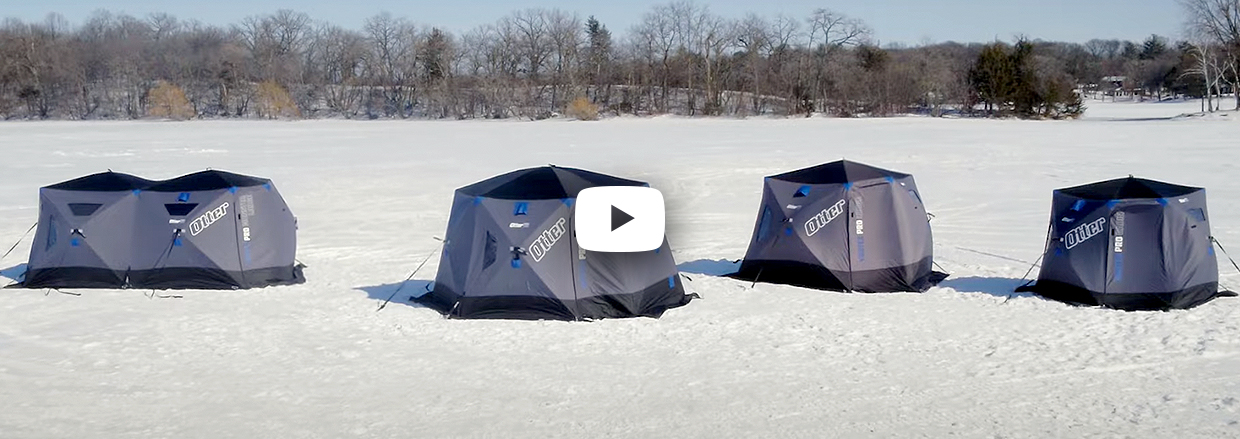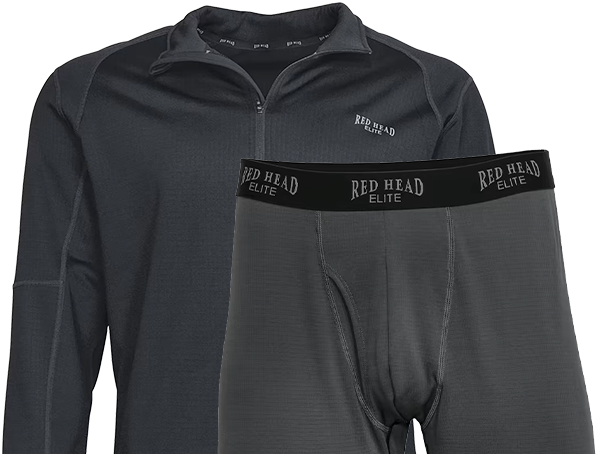
Staying Warm While Ice Fishing
It’s no secret that the open ice can be unforgiving if you aren’t properly prepared. Leave no accessory behind when it comes to keeping yourself warm while you keep your winter adventures on!
With the right shelter, clothing and gear, the cold will be the furthest thing from your mind. Whether you are in it for the long haul or just looking for a fun afternoon escape, Bass Pro Shops and Cabela’s has you covered to keep the cold at bay.
How to Pick Ice Shelters for Ice Fishing

Featuring easy exit, no-trip doors, and patented Otter Thermal Tec Fabric, the Otter Vortex Pro Hub Series provides the perfect mix of comfort and convenience for your next ice fishing adventure.
When choosing an ice shelter for ice fishing, remember that some are designed with outstanding mobility while others are not. There are three basic ice shelter styles: the Flip, Hub, and Cabin.
Here is a breakdown of pros and cons of each ice shelter style.
Flip-Style Shelters
Best For
- If you enjoy testing out more than one spot a day, and looking for angling mobility, or drive a snowmobile, go with a Flip shelter
Pros
- Highly portable and easy to transport
- Comes with a sled to store your gear
- Has solid framework that can stand up against wind
Cons
- It has the highest price per square foot
- It is heavier and could be difficult to drag it manually
- It is limited to a few anglers
Unit Weight
- Avg. 96 lb. (36 – 134 lb.)
Number of Anglers
- 1—3
Price
- $$—$$$
Hub-Style Shelters
Best For
- This is for anglers who like to stay put for the day
Pros
- Easy to set up (pops up like a tent)
- Lowest price per square foot
Cons
- High winds can make it difficult to setup
- It needs to be anchored to the ice
- Sled transport is not included
Unit Weight
- Avg. 40 lb. (22 – 62 lb.)
Number of Anglers
- 2—9
Price
- Every price range
Cabin-Style Shelters
Best For
- Anglers who prefer longer stays with stability and durability in windy conditions
Pros
- Cabin shelters have solid floors that provides better insulation from the ice
- Spacious with room for seating and gear
- Provides insulation and durability under harsh conditions
- Easy to setup
Cons
- They can be difficult to move around, especially in snow
- They do not come with an ice sled or have built-in seats
Unit Weight
- Avg. 40 lb. to 150 lb.
Number of Anglers
- 2—4
Price
- $$$—$$$$
Considerations When Buying a Portable Ice Shelter
Here are a few considerations before investing in an ice shelter for your ice fishing adventures.

Material of Portable Ice Fishing Shelters
Portable ice shelters mainly come in canvas or polyester and nylon. More than the type of the material, look for thickness and strength to separate the good from the mediocre.
A thick, tough, tear resistant, breathable, and water-resistant outer shell will extend the life of your shelter and will help you in keeping warm.
Pro Tip: Try to purchase a dark material that will absorb the sun’s warmth and help in cutting down the heating costs.
Understanding Deniers
The thickness of the fabric is measured in deniers.
For example, a shelter made of 200-deniers is less thick and durable than a shelter made of 600-deniers. While a high-denier fabric will withstand rips and freezing winds, it is heavy and expensive.
Size of a Portable Ice Fishing Shelter
Size determines how many people you are willing to invite. Ice shelters come in assorted sizes starting from a single-person tent to four or six-person ice fishing tents.
- Single-person tent is small, lightweight, easy to transport and holds up warmth well. There are varied sizes to choose from in single person ice fishing tents depending on your needs, body size and budget.
- If you prefer more room or carry a lot of gear, a two-person portable ice fishing tent is suitable. You can also add a couple of chairs for yourself and your friend while ice fishing. Although moving up the size could increase your purchase cost, the extra space and warmth is worth your investment.
- For ice anglers who wish to bring along their families or more angling comrades, a four or six-man cabins or systems that are used to connect two smaller shelters is preferrable. This comes with extra weight, size and would require a truck or a trailer to transport it to the ice.
Hauling Your Portable Ice Shelter
While you can haul your portable ice shelter by hand or a snow machine, having a built-in sled on the bottom of your shelter comes handy. Most portables can fold down into compact sleds that helps in holding all your essentials: bait buckets, augers, sonars, and other accessories.
Pro Tip: As you will be pulling the shelter back and forth, ensure the ropes are easy on your hands, are thick and strong to avoid the sled nipping at your heels.
You May Also Need:
The Art of Layering for Winter
With all the action happening below the ice, you can’t forget the gear you need to withstand the elements of a harsh winter.
Bass Pro Shops and Cabela's will outfit your ice fishing and winter adventures inside out, from head to toe, no matter the frigid temperatures.
Learn to choose the right layers for better regulation of body temperature, mobility and increased warmth while on ice.
Layer 1: Base Layer
Choose moisture-wicking pieces that stay tight to your skin. The prime responsibility for this layer is to wick any moisture away from your skin. If moisture is trapped, you will instantly feel cold when you stop moving. Choose a fabric weight appropriate for the temperatures you will fish in.
Tip: Adding extra bulk when you don’t need it may cause perspiration, making you cold once you get outside. When travelling to their destination, many outdoor enthusiasts wear only their base layer and opt to add other layers right before going out.
Layer 2: Mid-Layer
The main role of this layer is to add insulation. You’ll want to choose pieces that add warmth without bulking so you can still be mobile. Fleece is an excellent option for this layer.
Choose something not snug to the body but not too loose so that all your warmth escapes. If you are staying in an insulated and heated ice shelter, this will likely be all you need for most of the day.
Layer 3: Outerwear
This layer protects the layers within from the elements, such as wind and snow. Your outer layer should fit comfortably over your other layers but not too loose so that your body heat escapes. For an added benefit, Cabela's Canada also offers outerwear with FAST (Flotation Assistance Safety Technology) to provide buoyancy in case of a fall through the ice.
More Tips for Staying Warm
- Keep an extra pair of gloves or mitts in your vehicle. This is a good idea for other articles of clothing in the event of unexpected moisture or cold.
- Bring a towel or two to dry your skin without using the material or fabric from your clothing. This can cause heat loss and uncomfortable wetness.
- Stay active. If you sit in one place for a long period, you won’t work up any body heat to keep your blood flowing. Even though you might be near a heater, do your body a favour and get the internal body heat going with motion.


